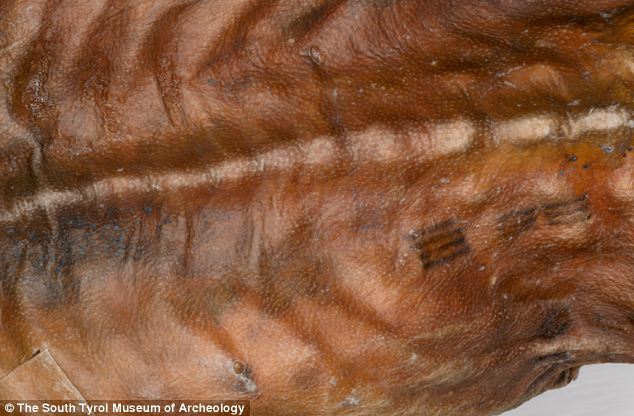It has long been thought that Stone Age man abandoned their dead with little thought or respect.
But the discovery of cremated bone, thought to be the earliest ever identified in Britain, could re-write the history of Mesolithic, or Middle Stone Age, burial practices.
The deposit containing the bone was discovered during excavations ahead of a new pipeline in Langford, Essex and is thought to date to 5,600 BC.
The burnt material, which includes approximately just over four ounces (118g) of cremated bone, was uncovered by Oxford Archaeology.
It was placed into a pit with a diameter of about three feet (one metre) and then backfilled with soil.
Three radiocarbon dates, two from bone fragments and one from charcoal, have confirmed the remains are around 7,614 years old and fall within the the late Mesolithic, between 6,000 BC and 4,000 BC.
Nick Gilmour, who lead the excavation, said ‘We were expecting this cremation to date to the Bronze Age - we were so surprised when the first radiocarbon date came back as Mesolithic that we did two more to double-check.’
Oldest evidence of human cremation in Britain unearthed: Stone Age men placed bodies on funeral pyres 7,600 years ago
Bone from more than one human dates to the Late Mesolithic in 5,600 BC
It was recovered from a pit with charcoal remains, in Langford, Essex
Evidence suggests ancient people respected and cremated their dead
It was previously thought that nomadic people simply abandoned them
By Sarah Griffiths for MailOnline
15 April 2015
Daily Mail
It has long been thought that Stone Age man abandoned their dead with little thought or respect.
But the discovery of cremated bone, thought to be the earliest ever identified in Britain, could re-write the history of Mesolithic, or Middle Stone Age, burial practices.
The deposit containing the bone was discovered during excavations ahead of a new pipeline in Langford, Essex and is thought to date to 5,600 BC.
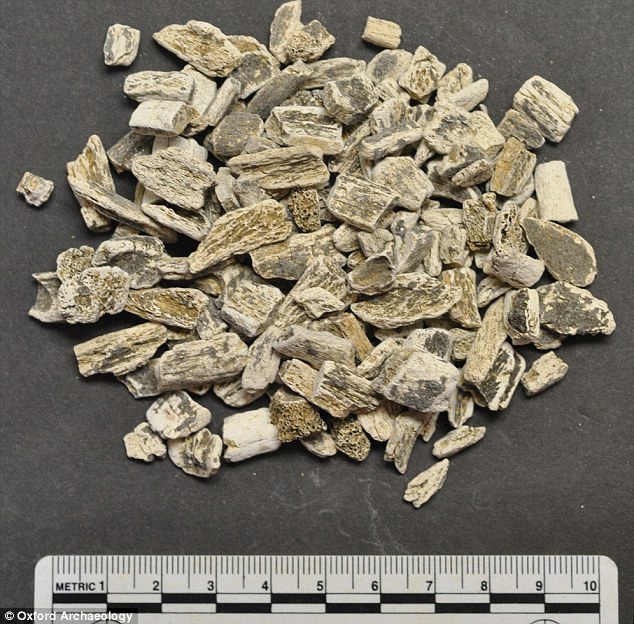
The discovery of cremated bone (pictured), thought to be the earliest ever identified in Britain, could re-write the history of Mesolithic, or Middle Stone Age, burial practices
The burnt material, which includes approximately just over four ounces (118g) of cremated bone, was uncovered by Oxford Archaeology.
It was placed into a pit with a diameter of about three feet (one metre) and then backfilled with soil.
Three radiocarbon dates, two from bone fragments and one from charcoal, have confirmed the remains are around 7,614 years old and fall within the the late Mesolithic, between 6,000 BC and 4,000 BC.
Nick Gilmour, who lead the excavation, said ‘We were expecting this cremation to date to the Bronze Age - we were so surprised when the first radiocarbon date came back as Mesolithic that we did two more to double-check.’
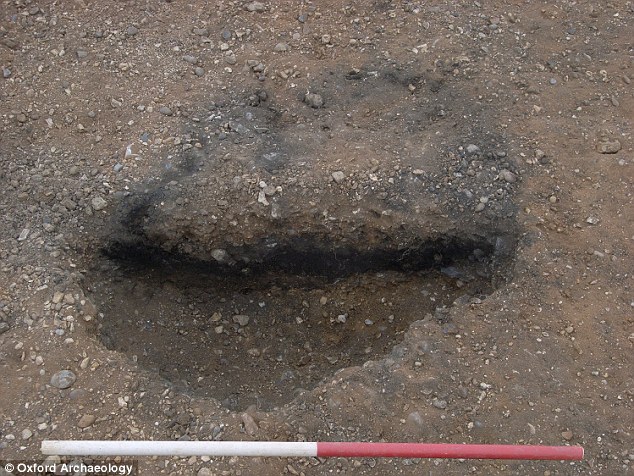
The burnt material, which includes approximately just over four ounces (118g) of cremated bone, was uncovered by Oxford Archaeology. It was placed into a pit (pictured) with a diameter of about three feet (one metre) and then backfilled with soil
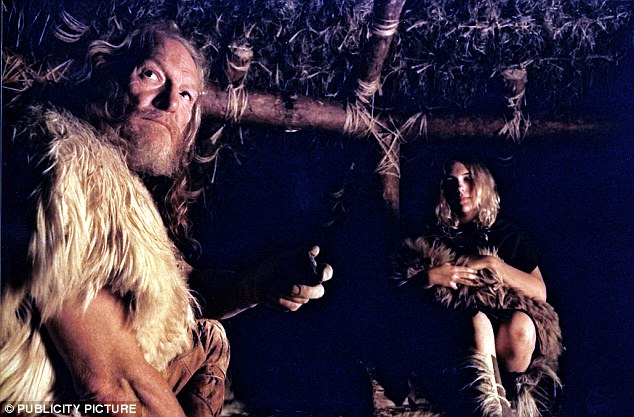
Little is known about Mesolithic man's beliefs, but the pit shows that ancient people understood how to create a pyre that was hot enough at over 600 °C to completely burn a corpse and appeared to respect the dead. This image is a still from a BBC TV show called Meet the Ancestors showing what a Mesolithic hut may have looked like
Dr Louise Loe, head of burials at Oxford Archaeology, analysed the bone to find that it represents the remains of at least one adult, despite the total weight being around seven per cent of what would be expected from a complete individual.
Taken alongside evidence of a large amount of charcoal in the pit, it’s thought the material represents a deposit of some of the remains from a pyre, and not all of the cremated bone from it.
The find is significant because it sheds light on early human society in Mesolithic Britain, when people were largely nomadic hunter gatherers before the arrival of farming.
While little is known about their beliefs, the pit shows that ancient people understood how to create a pyre that was hot enough - at over 600°C - to completely burn a corpse.
It hints that people respected the dead enough to cremate them and not simply abandon them, as has been previously believed.

The deposit containing the bone was discovered during excavations ahead of a new pipeline in Langford, Essex (shown on the map) and is thought to date to 5,600 BC
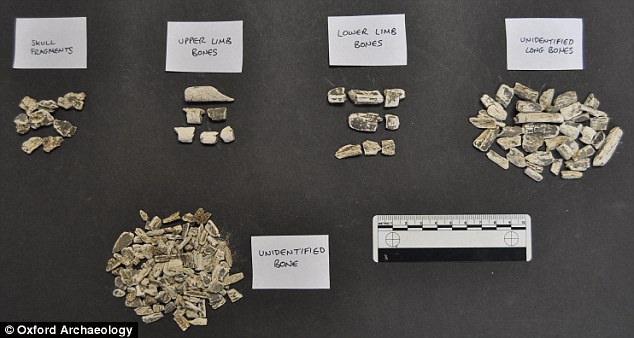
Three radiocarbon dates, two from bone fragments and one from charcoal, have confirmed the remains are around 7,614 years old. Here, the bone fragments are sorted into types
Time and resources were invested in funerary practices despite a mobile hand-to-mouth existence, the experts explained.
Before the discovery, just 20 examples of human bone dating from the British Mesolithic, which spans from 10,000 to 4,000BC, were found – and none of them had been cremated.
But a group of three cremations from the period have been found in Ireland, so the ‘new’ site seems to fit into a wider European pattern of behaviour.
Three Mesolithic flints were also discovered in the pit and while none are finished tools, they are sharp enough to have been used for cutting.
More flints were found nearby, as well as a Bronze Age barrow, Early Roman site, Saxon settlement and a medieval building all where the Essex and Suffolk Water pipeline is planned.
THE SIGNIFICANCE OF THE FIND
The find is significant because it sheds light on early human society in Mesolithic Britain, when people were largely nomadic hunter gatherers before the arrival of farming.
While little is known about their beliefs, the pit shows that ancient people understood how to create a pyre that was hot enough - at over 600 °C - to completely burn a corpse.
It hints that people respected the dead enough to cremate them and not simply abandon them, as has been previously believed.
Time and resources were invested in funerary practices despite a mobile hand-to-mouth existence, the experts explained.

The find is significant because it sheds light on early human society in Mesolithic Britain, when people were largely nomadic hunter gatherers before the arrival of farming. Here, excavator Malgorzata Kwiatowska records finds
But the discovery of cremated bone, thought to be the earliest ever identified in Britain, could re-write the history of Mesolithic, or Middle Stone Age, burial practices.
The deposit containing the bone was discovered during excavations ahead of a new pipeline in Langford, Essex and is thought to date to 5,600 BC.
The burnt material, which includes approximately just over four ounces (118g) of cremated bone, was uncovered by Oxford Archaeology.
It was placed into a pit with a diameter of about three feet (one metre) and then backfilled with soil.
Three radiocarbon dates, two from bone fragments and one from charcoal, have confirmed the remains are around 7,614 years old and fall within the the late Mesolithic, between 6,000 BC and 4,000 BC.
Nick Gilmour, who lead the excavation, said ‘We were expecting this cremation to date to the Bronze Age - we were so surprised when the first radiocarbon date came back as Mesolithic that we did two more to double-check.’
Oldest evidence of human cremation in Britain unearthed: Stone Age men placed bodies on funeral pyres 7,600 years ago
Bone from more than one human dates to the Late Mesolithic in 5,600 BC
It was recovered from a pit with charcoal remains, in Langford, Essex
Evidence suggests ancient people respected and cremated their dead
It was previously thought that nomadic people simply abandoned them
By Sarah Griffiths for MailOnline
15 April 2015
Daily Mail
It has long been thought that Stone Age man abandoned their dead with little thought or respect.
But the discovery of cremated bone, thought to be the earliest ever identified in Britain, could re-write the history of Mesolithic, or Middle Stone Age, burial practices.
The deposit containing the bone was discovered during excavations ahead of a new pipeline in Langford, Essex and is thought to date to 5,600 BC.

The discovery of cremated bone (pictured), thought to be the earliest ever identified in Britain, could re-write the history of Mesolithic, or Middle Stone Age, burial practices
The burnt material, which includes approximately just over four ounces (118g) of cremated bone, was uncovered by Oxford Archaeology.
It was placed into a pit with a diameter of about three feet (one metre) and then backfilled with soil.
Three radiocarbon dates, two from bone fragments and one from charcoal, have confirmed the remains are around 7,614 years old and fall within the the late Mesolithic, between 6,000 BC and 4,000 BC.
Nick Gilmour, who lead the excavation, said ‘We were expecting this cremation to date to the Bronze Age - we were so surprised when the first radiocarbon date came back as Mesolithic that we did two more to double-check.’

The burnt material, which includes approximately just over four ounces (118g) of cremated bone, was uncovered by Oxford Archaeology. It was placed into a pit (pictured) with a diameter of about three feet (one metre) and then backfilled with soil

Little is known about Mesolithic man's beliefs, but the pit shows that ancient people understood how to create a pyre that was hot enough at over 600 °C to completely burn a corpse and appeared to respect the dead. This image is a still from a BBC TV show called Meet the Ancestors showing what a Mesolithic hut may have looked like
Dr Louise Loe, head of burials at Oxford Archaeology, analysed the bone to find that it represents the remains of at least one adult, despite the total weight being around seven per cent of what would be expected from a complete individual.
Taken alongside evidence of a large amount of charcoal in the pit, it’s thought the material represents a deposit of some of the remains from a pyre, and not all of the cremated bone from it.
The find is significant because it sheds light on early human society in Mesolithic Britain, when people were largely nomadic hunter gatherers before the arrival of farming.
While little is known about their beliefs, the pit shows that ancient people understood how to create a pyre that was hot enough - at over 600°C - to completely burn a corpse.
It hints that people respected the dead enough to cremate them and not simply abandon them, as has been previously believed.

The deposit containing the bone was discovered during excavations ahead of a new pipeline in Langford, Essex (shown on the map) and is thought to date to 5,600 BC

Three radiocarbon dates, two from bone fragments and one from charcoal, have confirmed the remains are around 7,614 years old. Here, the bone fragments are sorted into types
Time and resources were invested in funerary practices despite a mobile hand-to-mouth existence, the experts explained.
Before the discovery, just 20 examples of human bone dating from the British Mesolithic, which spans from 10,000 to 4,000BC, were found – and none of them had been cremated.
But a group of three cremations from the period have been found in Ireland, so the ‘new’ site seems to fit into a wider European pattern of behaviour.
Three Mesolithic flints were also discovered in the pit and while none are finished tools, they are sharp enough to have been used for cutting.
More flints were found nearby, as well as a Bronze Age barrow, Early Roman site, Saxon settlement and a medieval building all where the Essex and Suffolk Water pipeline is planned.
THE SIGNIFICANCE OF THE FIND
The find is significant because it sheds light on early human society in Mesolithic Britain, when people were largely nomadic hunter gatherers before the arrival of farming.
While little is known about their beliefs, the pit shows that ancient people understood how to create a pyre that was hot enough - at over 600 °C - to completely burn a corpse.
It hints that people respected the dead enough to cremate them and not simply abandon them, as has been previously believed.
Time and resources were invested in funerary practices despite a mobile hand-to-mouth existence, the experts explained.

The find is significant because it sheds light on early human society in Mesolithic Britain, when people were largely nomadic hunter gatherers before the arrival of farming. Here, excavator Malgorzata Kwiatowska records finds
Last edited:


